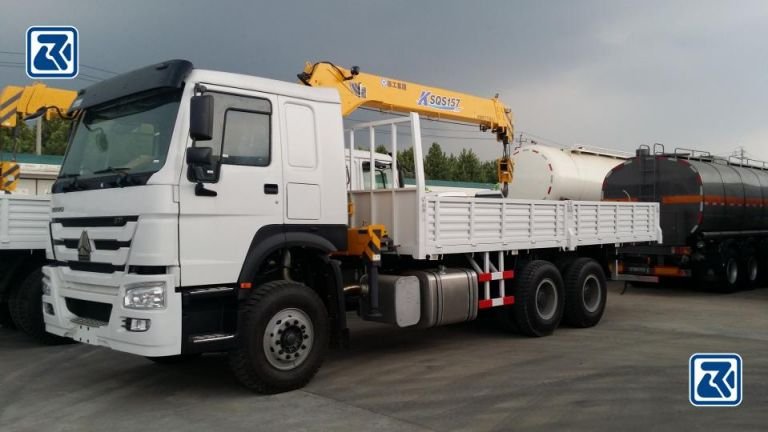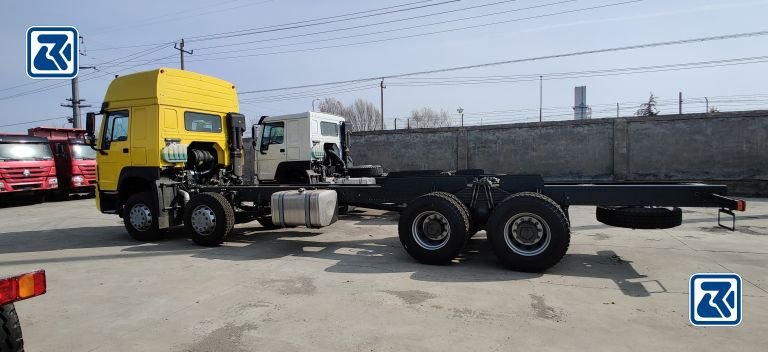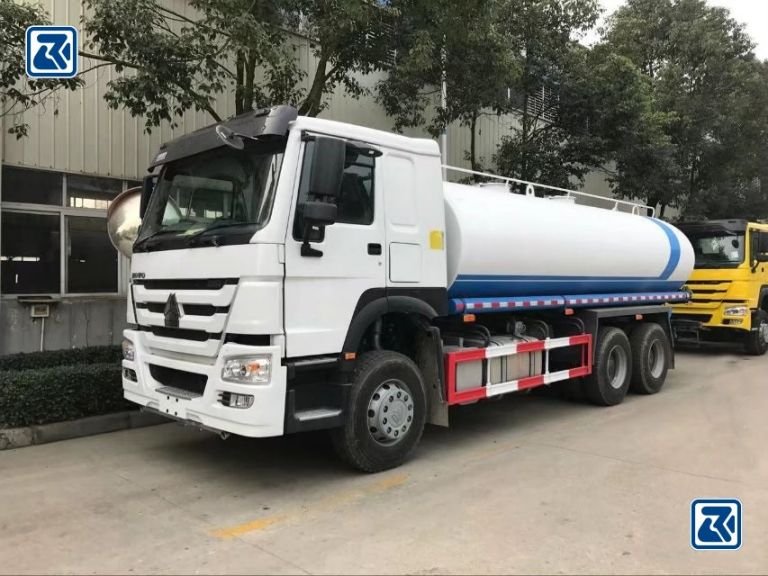HOWO cranes are highly efficient vehicle lifting equipment widely used in construction, transportation and logistics. They excel at handling complex tasks such as heavy lifting, equipment handling and building construction, and are favored for their strong load carrying capacity and flexible operating performance. Improving the efficiency of HOWO cranes is crucial to completing complex projects, saving time and reducing costs. Efficient operation not only optimizes the crane’s performance, but also significantly improves project success, ensures on-time completion and reduces unnecessary expenses. In the next section, we will share some practical tips to help you maximize your crane’s efficiency.
Table of Contents
Understanding the crane's working range and limitations
When planning a HOWO crane task, the first thing you need to know is its technical specifications, including maximum lifting capacity and working radius. This data helps determine the maximum load the crane can handle and the operating range it can reach. It is also important to know the crane’s operating limits, as heavy loads or unsuitable environmental conditions, such as strong winds or uneven ground, can lead to accidents or equipment damage. When assigning tasks appropriately, they can be completed in stages based on load capacity and work radius to avoid overloading and to ensure that each operation is within the safe operating range of the crane. This not only improves the efficiency of the crane, but also optimizes the progress and safety of the entire project.

Regular maintenance and inspection of equipment
Regular maintenance is a key measure to ensure maximum crane performance over time. Regular inspection and maintenance can significantly reduce the likelihood of breakdowns, thereby improving efficiency and extending the service life of the equipment.
Hydraulic system maintenance: The hydraulic system is the core component of the crane, and regular checking of the hydraulic oil level is a basic requirement to ensure that the system operates with sufficient oil. In addition, should also check the condition of hydraulic piping and fittings to ensure that there is no leakage or damage. Leakage of hydraulic oil will not only affect the lifting performance, but also may lead to safety hazards.
Mechanical system maintenance: Critical parts of the mechanical system such as the boom and winch need to be lubricated regularly to minimize wear and friction and keep the equipment running efficiently. At the same time, check the wear and tear of the boom and winch, and replace damaged parts in a timely manner to prevent sudden failures during operation.
Electrical system maintenance: The stability of the electrical system is crucial to the normal operation of the crane. Regularly check the battery power to ensure that it is sufficient. Connections to wiring and control systems should also be checked regularly to prevent equipment failure due to electrical faults.
With preventive maintenance, potential problems can be identified before they occur so that they can be repaired in a timely manner. This approach not only reduces unexpected downtime, but also improves the efficiency of the crane and ensures that the project runs smoothly and on schedule.
Get a tailored quote today and elevate your transport efficiency.
Operator Training
Importance of training: Adequate HOWO crane operator training is essential. Professional training ensures that operators are familiar with the equipment’s functions and operating specifications, thereby improving operational safety and efficiency. Training should cover basic crane operations, safety procedures, and emergency response skills to ensure that operators can use the crane efficiently and safely under a variety of working conditions.
Operational Skills
Smooth lifting: operators should learn to lift and lower loads smoothly, avoiding sudden acceleration or deceleration. This helps prevent the load from swinging, improves operational accuracy, and reduces wear and tear on the equipment.
Accurate Placement: The operator should place the load accurately through careful control. This often requires practice and good spatial awareness to ensure that the load is placed exactly where it is intended.
Effective Winch Use: Proper winch use is one of the core skills of crane operation. Operators should understand winch speed control and load distribution to avoid overloading or equipment damage.
Time-saving tip
Set up the crane quickly: operators should familiarize themselves with the crane setup process, including adjusting outriggers and configuring spreaders, to reduce equipment preparation time.
Communicate effectively: Effective communication between the operator and ground command is key when performing lifting operations. The use of standard hand signals or radio communication can improve coordination and avoid delays caused by poor messaging.
Coordinate work: Coordinating work with other equipment operators or workers to ensure smooth connections can significantly improve efficiency.
Reduce errors and accidents: Operators should follow strict best practices, including regularly checking the condition of equipment, following operating procedures, and being vigilant. Regular participation in safety training and drills can help improve operator emergency response and reduce accidents caused by human error. Through continuous learning and practice, operators can make quick and sound decisions in complex work environments, further improving overall productivity.
Use of advanced technology and tools
The application of advanced technology on HOWO cranes can significantly improve work efficiency and safety in the following aspects:
Automatic control system
Automatic leveling adjustment: modern cranes are equipped with an automatic leveling adjustment system that can automatically correct the leveling status of the crane. The system detects the crane’s tilt angle in real-time through sensors and automatically adjusts the outriggers to ensure that the equipment remains smooth in any situation. This technology reduces the operator’s workload and avoids operational accidents caused by imbalance.
Load Sensor Technology: The load Sensor monitors the weight of the load on the crane in real time to ensure that the load is within the safe load-bearing range of the equipment. It provides instant feedback to help operators avoid overloading, thus improving crane safety. In addition, load sensors improve operational accuracy, ensuring that loads are placed accurately.
Remote Monitoring System
GPS Location: With GPS technology, operators and managers can track the crane’s location in real-time. This capability is especially important in large projects, helping to coordinate different equipment and personnel and optimize workflow.
Remote diagnostic tools: The remote diagnostic system can monitor the crane’s performance data in real-time, including engine status, hydraulic system pressure, and electrical system health. When a fault occurs, the system can send an alert in advance so that operators and maintenance personnel can take timely action to avoid downtime due to equipment failure.
Improve operational efficiency and safety
Improved efficiency: Automated control systems reduce the operator’s reliance on precise operation, making the crane more efficient in adjustments and load control. The data analysis provided by the remote monitoring system can help managers optimize crane use and scheduling, thus improving overall operational efficiency.
Improved safety: Automation technology and remote monitoring systems reduce the likelihood of human error and equipment failure. Load sensors avoid overloading problems, automatic leveling systems reduce accidents caused by equipment imbalance, and remote diagnostics provide early warning before failures occur, ensuring safe equipment operation.

Improve fuel efficiency and reduce operating costs
Improving fuel efficiency and reducing operating costs is critical to the long-term operation of HOWO cranes. Here are some strategies for optimizing crane fuel use and how to implement them to improve overall productivity:
Optimizing Fuel Use
Reduce idling:
Avoid unnecessary idling: cranes still consume fuel when idling. Operators should try to avoid prolonged idling when not needed. For example, after completing a lifting operation, the operator should turn off the engine as soon as possible rather than leaving it running.
Use an automatic engine shutdown system: Modern cranes may be equipped with an automatic engine shutdown system that automatically shuts off the engine when the vehicle has been inactive for an extended period, thereby reducing idling time. Using this system can effectively reduce fuel consumption.
Efficient driving:
Optimize driving routes: operators should plan the most direct route to avoid unnecessary detours or repetitive operations. This not only saves fuel but also reduces wear and tear on the equipment.
Avoid sharp turns and braking: Sharp turns and braking lead to increased fuel consumption as these operations require more power and fuel. Operators should drive smoothly to reduce such strenuous operations, thus improving fuel efficiency.
Proper use of loads: Ensure that the crane is loaded as designed, neither overloaded nor underloaded. Overloading will result in increased engine load and more fuel consumption.
Use efficient fuel:
Choose the right fuel: use high-efficiency fuel that meets the specifications of HOWO cranes and ensure that the quality and type of fuel maximize combustion efficiency. High-quality fuel improves combustion efficiency and reduces emissions, thereby reducing fuel consumption.
Regularly clean the fuel system: Regularly check and maintain the fuel system, including replacing the fuel filter and cleaning the injector nozzles. This ensures optimal operation of the fuel system and avoids wasted fuel due to fuel supply problems.
Continue reading: HOWO truck-mounted crane fuel consumption
Improve overall efficiency
Integrated optimization: By implementing the above measures, fuel consumption and operating costs can be significantly reduced. Reduced idling, optimized driving, and the use of efficient fuels not only save on fuel costs but also reduce the crane’s operating costs and improve overall work efficiency.
Regular maintenance: In addition to the above measures, regular crane maintenance is key to improving fuel efficiency. Ensure that the engine, transmission system, and other key components are in good condition to improve fuel economy.
Train operators: Train operators on fuel economy and how to reduce fuel consumption through efficient driving and proper operation. This will help operators better apply these strategies in the real world to improve fuel efficiency.
Get a tailored quote today and elevate your transport efficiency.
Site management and task planning
Effective site management and task planning are critical to improving crane efficiency. The following are ways to reduce delays and duplication of effort in crane operations through task prioritization, optimized site layout, and proper planning and management.
Task prioritization
Urgency and Importance: categorize site tasks to determine which tasks have a high degree of urgency and importance and prioritize those tasks. For example, on a construction site, there may be tasks that must be completed before subsequent work can be performed.
Rationalize resource allocation: Allocate cranes and other equipment according to task priority. Higher-priority tasks can be allocated more resources to ensure they are completed on time, thus increasing overall productivity.
Real-time adjustments: tasks on-site may change due to unforeseen circumstances. Develop flexible task planning so that resources and schedules can be quickly adjusted to minimize disruption to existing work as new and urgent tasks arise.
Communicate and coordinate: Maintain good communication between site managers, operators, and other relevant personnel to ensure that everyone is aware of current task priorities and changes so that they can respond and adjust quickly.
Optimize site layout
Reasonable planning of the work area: When planning the site layout, ensure that cranes and other equipment have enough operating space. Avoid placing cranes in locations with narrow spaces or poor access to prevent restricted operation.
Clear marking: Use signage or lines to clarify the working areas of cranes and other equipment to avoid confusion and accidental collisions and improve work efficiency.
Clean up the site: Regularly check and clean up obstacles at the site, such as building materials, temporary facilities, or construction debris, to ensure that cranes are not obstructed during operation.
Optimize access design: Design a reasonable access layout to ensure that cranes can pass through smoothly and can quickly move to other work areas when needed.
Reduce delays and duplication of effort
Detailed task planning: Carry out detailed task planning before construction, including the sequence of crane operations, time estimates for each task, and the resources required. This avoids delays caused by improper task scheduling during operations.
Advance coordination: Coordinate tasks and resources with relevant personnel in advance to ensure that all operational aspects can be smoothly connected, avoiding delays caused by miscommunication or shortage of resources.
Real-time monitoring: Use remote monitoring systems and on-site management tools to track the work status and task progress of cranes in real-time, and identify and solve potential problems promptly to reduce delays.
Standardized Operating Procedures: Develop standardized operating procedures and work instructions to ensure that all operators work by established procedures, avoiding duplication of effort due to improper operation.
Post-task evaluation: After task completion, site management and task planning are evaluated for lessons learned. This helps to optimize planning and management in future projects and reduce the occurrence of similar problems.
Continuous Improvement: Continuous improvement is carried out based on the assessment results to optimize the task arrangement and site layout to continuously improve the efficiency and effectiveness of crane operations.
Conclusion
It is crucial to improve the efficiency of HOWO cranes, which can significantly improve construction efficiency, reduce costs, and ensure safety. Regular maintenance ensures stable operation, operator training improves skills and safety awareness, and technology application optimizes equipment performance. Readers are advised to adopt these methods to improve crane efficiency and consult HOWO Special Truck Ltd for professional advice and support to achieve the best results.
Related reading:Guide to choosing the right HOWO truck-mounted crane model
FAQ
How to improve the efficiency of HOWO cranes?
By optimizing operator training, regular maintenance, rational allocation of equipment, and introduction of advanced technology, the efficiency and safety of cranes can be improved in all aspects.
How to improve operator skills through training?
Systematic training helps operators master basic and advanced operation skills, enhance safety awareness, and conduct daily inspections to ensure efficient and safe operation of equipment.
How to use technology to optimize crane performance?
Introducing automatic control and real-time monitoring systems, combined with data analysis and intelligent technology, to optimize the accuracy, efficiency, and reliability of crane operations.
How does HOWO Special Truck Ltd help customers improve efficiency?
Through customized training, technical support, regular maintenance, and personalized solutions, HOWO Special Truck Ltd comprehensively improves the efficiency and safety of customers’ cranes.



